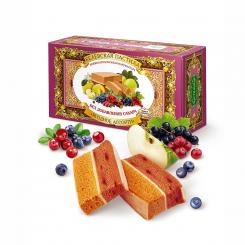Pastila Belyov
Belevskaya Pastila is made exclusively by hand from juicy Antonov apples using a thoroughly unique technology.
This type of technology is among the most unique in the world. Belevskaya Pastila is made by hand in a Russian oven, without preservatives, dyes or flavor enhancers.
Since ancient times, there has been the problem of preserving large apple harvests over the winter months.
After the harvest, the hostesses roasted the apples in the oven, rubbed them on a hair sieve and whipped the apple puree with honey and egg white for up to two days,
until the volume of the mass doubled.
The whipped mass was poured ("spread" - hence the name pastila) into wooden molds and dried in a Russian oven for two to three days.
From the obtained layers, pies were formed, poured over with the beaten mass and put in the oven for a day.
Then they cut the pies into loaves, beat them again and put them in the oven for another day.
The finished pastila loaves were wrapped in the fabric and put in the cellar, where they were kept until the next apple harvest.
Later, at the end of the nineteenth century, sugar became available and began to be used instead of honey.
This type of technology is among the most unique in the world. Belevskaya Pastila is made by hand in a Russian oven, without preservatives, dyes or flavor enhancers.
Since ancient times, there has been the problem of preserving large apple harvests over the winter months.
After the harvest, the hostesses roasted the apples in the oven, rubbed them on a hair sieve and whipped the apple puree with honey and egg white for up to two days,
until the volume of the mass doubled.
The whipped mass was poured ("spread" - hence the name pastila) into wooden molds and dried in a Russian oven for two to three days.
From the obtained layers, pies were formed, poured over with the beaten mass and put in the oven for a day.
Then they cut the pies into loaves, beat them again and put them in the oven for another day.
The finished pastila loaves were wrapped in the fabric and put in the cellar, where they were kept until the next apple harvest.
Later, at the end of the nineteenth century, sugar became available and began to be used instead of honey.
Account



